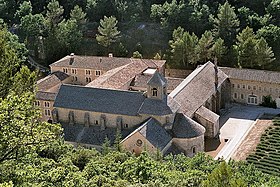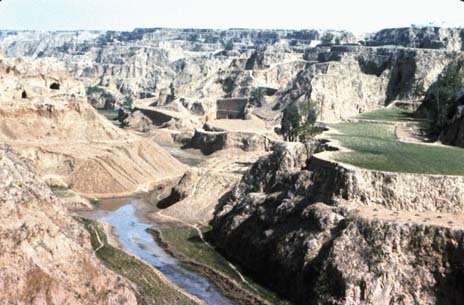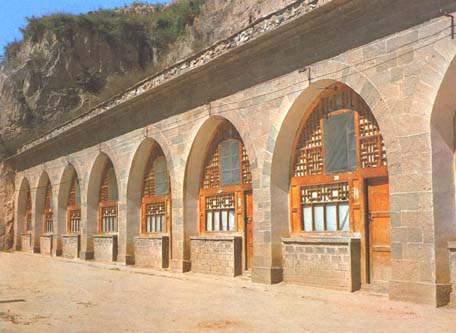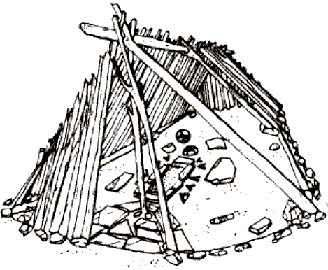As a process, architecture is the activity of designing and constructing buildings and other physical structures by a person or a machine, primarily done to provide socially purposeful shelter. A wider definition often includes the design of the total built environment, from the macro level of how a building integrates with its surrounding man made landscape (see town planning, urban design, and landscape architecture) to the micro level of architectural or construction details and, sometimes, furniture. Wider still, architecture is the activity of designing any kind of system.
As a profession, architecture is the role of those persons or machines providing architectural services.
As documentation, usually based on drawings, architecture defines the structure and/or behavior of a building or any other kind of system that is to be or has been constructed.
Architects have as their primary object providing for the spatial and shelter needs of people in groups of some kind (families, schools, churches, businesses, etc.) by the creative organisation of materials and components in a land- or city-scape, dealing with mass, space, form, volume, texture, structure, light, shadow, materials, program, and pragmatic elements such as cost, construction limitations and technology, to achieve an end which is functional, economical, practical and often with artistic and aesthetic aspects. This distinguishes architecture from engineering design, which has as its primary object the creative manipulation of materials and forms using mathematical and scientific principles.
Separate from the design process, architecture is also experienced [1] through the senses, which therefore gives rise to aural [2] , visual, olfactory [3], and tactile [4] architecture. As people move through a space, architecture is experienced as a time sequence. [5] Even though our culture considers architecture to be a visual experience, the other senses play a role in how we experience both natural and built environments. Attitudes towards the senses depend on culture [6]. The design process and the sensory experience of a space are distinctly separate views, each with its own language and assumptions.
Architectural works are perceived as cultural and political symbols and works of art. Historical civilizations are often known primarily through their architectural achievements. Such buildings as the pyramids of Egypt and the Roman Colosseum are cultural symbols, and are an important link in public consciousness, even when scholars have discovered much about a past civilization through other means. Cities, regions and cultures continue to identify themselves with (and are known by) their architectural monuments.[7]


Brunelleschi, in the building of the dome, not only transformed the cathedral and the city of Florence, but also the role and status of the architect.
Etymology and application of the term
The word "architecture" comes from the Latin architectura and that from Greek αρχιτέκτων (architekton), "master builder", from the combination of αρχι- (archi-), "chief" or "leader" and τέκτων (tekton), a "builder" or "carpenter"[8][9]. While the primary application of the word "architecture" pertains to the built environment, by extension, the term has come to denote the art and discipline of creating an actual (or inferring an implied or apparent) plan of any complex object or system. The term can be used to connote the implied architecture of mathematics or of abstract things such as music, the apparent architecture of natural things, such as geological formations or the structure of biological cells, or explicitly planned architectures of human-made things such as software, computers, enterprises, and databases, in addition to buildings. In every usage, an architecture may be seen as a subjective mapping from a human perspective (that of the user in the case of abstract or physical artifacts) to the elements or components of some kind of structure or system, which preserves the relationships among the elements or components.
The Architect
Main article: architect


Design for a gardener's cottage and engine house in the grounds of a castle. Ludwig Persius, Berlin, 1836.
Architecture as a profession is the practice of providing architectural services. The practice of architecture includes the planning, designing and oversight of a building's construction by an architect. Architectural services typically address both feasibility and cost for the builder, as well as function and aesthetics for the user.
Architecture did not start to become professionalized until the late nineteenth century. Before then, architects had ateliers and architectural education varied, from a more formal training as at the École des Beaux-Arts in France, which was founded in the mid seventeenth century, to the more informal system where students worked in an atelier until they could become independent. There were also so-called gentlemen architects, which were architects with private means. This was a tradition particularly strong in England during the eighteenth and nineteenth centuries. Lord Burlington, designer of Chiswick House, (1723-49) is an example. Some architects were also sculptors, such as Bernini, theater designers such as Filippo Juvarra and John Vanbrugh, and painters, such as Michelangelo and Le Corbusier.
In the 1440s, the Florentine architect, Alberti, wrote his De Re Aedificatoria, published in 1485, a year before the first edition of Vitruvius, with which he was already familiar.[10].[11] Alberti gives the earliest definition of the role of the architect. The architect is to be concerned firstly with the construction. This encompasses all the practical matters of site, of materials and their limitations and of human capability. The second concern is "articulation"; the building must work and must please and suit the needs of those who use it. The third concern of the architect is aesthetics, both of proportion and of ornament.
The role of the architect is constantly evolving, and is central to the design and implementation of the environments in which people live. In order to obtain the skills and knowledge required to design, plan, and oversee a diverse range of projects, architects must go through extensive formal education, coupled with a requisite amount of professional practice.
The work of an architect is an interdisciplinary field, drawing upon mathematics, science, art, technology, social sciences, politics and history, and is often governed by the architect's personal approach or philosophy. Vitruvius, the earliest known architectural theorist, states: "Architecture is a science, arising out of many other sciences, and adorned with much and varied learning: by the help of which a judgement is formed of those works which are the result of other arts." He adds that an architect should be well versed in other fields of learning such as music and astronomy.[11] Vitruvius' broad definition of the architect still holds true to some extent today, even though business concerns and the computer have reshaped the activities and definition of the modern architect in significant ways.
Theory of Architecture
Historic treatises


Plan, front view and side view of a typical column of Persepolis palace of Persia.


Persepolis palace after 2500 years, Persia.
The earliest written work on the subject of architecture is De architectura, by the Roman architect Vitruvius in the early 1st century CE.[11] According to Vitruvius, a good building should satisfy the three principles of firmitatis utilitatis venustatis,[12] [13] which translates roughly as -
- Durability - it should stand up robustly and remain in good condition.
- Utility - it should be useful and function well for the people using it.
- Beauty - it should delight people and raise their spirits.
According to Vitruvius, the architect should strive to fulfil each of these three attributes as well as possible.


The Parthenon, Athens, "the supreme example among architectural sites." (Fletcher).[14]
Leone Battista Alberti, who elaborates on the ideas of Vitruvius in his treatise, De Re Aedificatoria, saw beauty primarily as a matter of proportion, although ornament also played a part. For Alberti, the rules of proportion were those that governed the idealised human figure, the Golden Mean. The most important aspect of beauty was therefore an inherent part of an object, rather than something applied superficially; and was based on universal, recognisable truths. The notion of style in the arts was not developed until the 16th century, with the writing of Vasari.[15] The treatises, by the 18th century, had been translated into Italian, French, Spanish and English.
In the early nineteenth century, Augustus Welby Northmore Pugin wrote Contrasts (1836) that, as the titled suggested, contrasted the modern, industrial world, which he disparaged, with an idealized image of neo-medieval world. Gothic architecture, Pugin believed, was the only “true Christian form of architecture.”
The 19th century English art critic, John Ruskin, in his Seven Lamps of Architecture, published 1849,[16] was much narrower in his view of what constituted architecture. Architecture was the "art which so disposes and adorns the edifices raised by men … that the sight of them" contributes "to his mental health, power, and pleasure". For Ruskin, the aesthetic was of overriding significance. His work goes on to state that a building is not truly a work of architecture unless it is in some way "adorned". For Ruskin, a well-constructed, well-proportioned, functional building needed string courses or rustication, at the very least.
On the difference between the ideals of "architecture" and mere "construction", the renowned 20th C. architect Le Corbusier wrote: "You employ stone, wood, and concrete, and with these materials you build houses and palaces: that is construction. Ingenuity is at work. But suddenly you touch my heart, you do me good. I am happy and I say: This is beautiful. That is Architecture".[17]


 Europe's Gate, Madrid; the first intentionally inclined buildings in the world.
Europe's Gate, Madrid; the first intentionally inclined buildings in the world.
Modern concepts of architecture
The great 19th century architect of skyscrapers, Louis Sullivan, promoted an overriding precept to architectural design: "Form follows function".
While the notion that structural and aesthetic considerations should be entirely subject to functionality was met with both popularity and scepticism, it had the effect of introducing the concept of "function" in place of Vitruvius "utility". "Function" came to be seen as encompassing all criteria of the use, perception and enjoyment of a building, not only practical but also aesthetic, psychological and cultural.
Nunzia Rondanini stated, "Through its aesthetic dimension architecture goes beyond the functional aspects that it has in common with other human sciences. Through its own particular way of expressing values, architecture can stimulate and influence social life without presuming that, in and of itself, it will promote social development. To restrict the meaning of (architectural) formalism to art for art's sake is not only reactionary; it can also be a purposeless quest for perfection or originality which degrades form into a mere instrumentality".[18]
Among the philosophies that have influenced modern architects and their approach to building design are rationalism, empiricism, structuralism, poststructuralism, and phenomenology.


Sydney Opera House, designed by Utzon. photo E.Lau.
In the late 20th century a new concept was added to those included in the compass of both structure and function, the consideration of sustainability. To satisfy the modern ethos a building should be constructed in a manner which is environmentally friendly in terms of the production of its materials, its impact upon the natural and built environment of its surrounding area and the demands that it makes upon non-sustainable power sources for heating, cooling, water and waste management and lighting
History
Main article: History of architecture


Vernacular architecture in Denmark.
Origins and the ancient world
Architecture first evolved out of the dynamics between needs (shelter, security, worship, etc.) and means (available building materials and attendant skills). As human cultures developed and knowledge began to be formalized through oral traditions and practices, architecture became a craft. Here there is first a process of trial and error, and later improvisation or replication of a successful trial. What is termed Vernacular architecture continues to be produced in many parts of the world. Indeed, vernacular buildings make up most of the built world that people experience every day.


Angkor, Cambodia.
Early human settlements were mostly rural. Due to a surplus in production the economy began to expand resulting in urbanization thus creating urban areas which grew and evolved very rapidly in some cases, such as that of Çatal Huyuk in Anatolia and Mohenjo Daro in Pakistan. In many ancient civilizations, like the Egyptians' and Mesopotamians', architecture and urbanism reflected the constant engagement with the divine and the supernatural, while in other ancient cultures such as Persia architecture and urban planning was used to exemplify the power of the state.
The architecture and urbanism of the Classical civilizations such as the Greek and the Roman evolved from civic ideals rather than religious or empirical ones and new building types emerged. Architectural styles developed.
Texts on architecture began to be written in the Classical period. These became canons to be followed in important works, especially religious architecture. Some examples of canons are found in the writings of Vitruvius, the Kao Gong Ji of ancient China[19] and Vaastu Shastra of ancient India.
The architecture of different parts of Asia developed along different lines to that of Europe, Buddhist, Hindu and Sikh architecture each having different characteristics. Buddhist architecture, in particular, showed great regional diversity. In many Asian countries a pantheistic religion led to architectural forms that were designed specifically to enhance the natural landscape.


The Taj Mahal, in India, is a UNESCO World Heritage Site and was cited as "the jewel of Muslim art in India and one of the universally admired masterpieces of the world's heritage."
The Medieval builder
Islamic architecture began in the 7th century CE, developing from the architectural forms of the ancient Middle East but developing features to suit the religious and social needs of the society. Examples can be found throughout the Middle East, North Africa and Spain, and were to become a significant stylistic influence on European architecture during the Medieval period.


Wells Cathedral, Somerset, England.
In Europe, in both the Classical and Medieval periods, buildings were not attributed to specific individuals and the names of the architects frequently unknown, despite the vast scale of the many religious buildings extant from this period. During the Medieval period guilds were formed by craftsmen to organise their trade and written contracts have survived, particularly in relation to ecclesiastical buildings. The role of architect was usually one with master builder, except in the case where a cleric, such as the Abbot Suger at Saint Denis, Paris, provided the design. Over time the complexity of buildings and their types increased. General civil construction such as roads and bridges began to be built. Many new building types such as schools, hospitals, and recreational facilities
Renaissance and the architect


La Rotonda, by Palladio.
With the Renaissance and its emphasis on the individual and humanity rather than religion, and with all its attendant progress and achievements, a new chapter began. Buildings were ascribed to specific architects - Brunelleschi, Alberti, Michelangelo, Palladio - and the cult of the individual had begun. But there was no dividing line between artist, architect and engineer, or any of the related vocations. At this stage, it was still possible for an artist to design a bridge as the level of structural calculations involved was within the scope of the generalist.
With the emerging knowledge in scientific fields and the rise of new materials and technology, architecture and engineering began to separate, and the architect began to lose ground on some technical aspects of building design. He therefore concentrated on aesthetics and the humanist aspects.


St Pancras Midland Hotel, London
There was also the rise of the "gentleman architect" who usually dealt with wealthy clients and concentrated predominantly on visual qualities derived usually from historical prototypes, typified by the many country houses of Great Britain that were created in the Neo Gothic or Scottish Baronial styles.
Formal architectural training, in the 19th century, at, for example Ecole des Beaux Arts in France, gave much emphasis to the production of beautiful drawings and little to context and feasibility. Effective architects generally received their training in the offices of other architects, graduating to the role from draughtsmen or clerks.
Meanwhile, the Industrial Revolution laid open the door for mass production and consumption. Aesthetics became a criterion for the middle class as ornamented products, once within the province of expensive craftsmanship, became cheaper under machine production. Vernacular architecture became increasingly ornamental. House builders could access current architectural design in their work by combining features found in pattern books and architectural journals.
Modernism and reaction of architecture
The dissatisfaction with such a general situation at the turn of the twentieth century gave rise to many new lines of thought that served as precursors to Modern Architecture. Notable among these is the Deutscher Werkbund, formed in 1907 to produce better quality machine made objects. The rise of the profession of industrial design is usually placed here.
Following this lead, the Bauhaus school, founded in Germany in 1919, consciously rejected history and looked at architecture as a synthesis of art, craft, and technology.
When Modern architecture was first practiced, it was an avant-garde movement with moral, philosophical, and aesthetic underpinnings. Immediately after World War I, pioneering modernist architects sought to develop a completely new style appropriate for a new post-war social and economic order, focused on meeting the needs of the middle and working classes. They rejected the architectural practice of the academic refinement of historical styles which served the rapidly declining aristocratic order.


Fallingwater by Frank Lloyd Wright.
The approach of the Modernist architects was to reduce buildings to pure forms, removing historical references and ornament in favor of functionalist details. Buildings that displayed their construction and structure, exposing steel beams and concrete surfaces instead of hiding them behind traditional forms, were seen as beautiful in their own right. Architects such as Mies van der Rohe worked to create beauty based on the inherent qualities of building materials and modern construction techniques, trading traditional historic forms for simplified geometric forms, celebrating the new means and methods made possible by the Industrial Revolution.
Many architects resisted Modernism, finding it devoid of the decorative richness of ornamented styles. As the founders of the International Style lost influence in the late 1970s, Postmodernism developed as a reaction against the austerity of Modernism. Robert Venturi's contention that a "decorated shed" (an ordinary building which is functionally designed inside and embellished on the outside) was better than a "duck" (a building in which the whole form and its function are tied together) gives an idea of this approach.
[edit] Architecture today


Gare do Oriente Railway Station, Lisbon, by Santiago Calatrava.
Part of the architectural profession, and also some non-architects, responded to Modernism and Postmodernism by going to what they considered the root of the problem. They felt that architecture was not a personal philosophical or aesthetic pursuit by individualists; rather it had to consider everyday needs of people and use technology to give a livable environment. The Design Methodology Movement involving people such as Christopher Alexander started searching for more people-oriented designs. Extensive studies on areas such as behavioral, environmental, and social sciences were done and started informing the design process.
As the complexity of buildings began to increase (in terms of structural systems, services, energy and technologies), architecture started becoming more multi-disciplinary. Architecture today usually requires a team of specialist professionals, with the architect being one of many, although usually the team leader.
During the last two decades of the twentieth century and into the new millennium, the field of architecture saw the rise of specializations by project type, technological expertise or project delivery methods. In addition, there has been an increased separation of the 'design' architect [a] from the 'project' architect [b].
Moving the issues of environmental sustainability into the mainstream is a significant development in the architecture profession. Sustainability in architecture was pioneered in the 1970s by architects such as Ian McHarg in the US and Brenda and Robert Vale in the UK and New Zealand. There has been an acceleration in the number of buildings which seek to meet green building sustainable design principles.
It is now expected that architects will integrate sustainable principles into their projects.[20]


Contemporary architecture in Bangalore, India
The American Institute of Architects acknowledges that half of today's global warming greenhouse gas emissions come from buildings - more than transportation or industry. [4] AIA states that immediate action by the building sector is essential to avoid hazardous man-made climate change. They have an "Architecture 2030" plan [5] to reduce new building energy consumption by 90% in 2030, and net zero greenhouse gas emissions by 2035. Passive solar building design has been demonstrating essential elements of 70% to 90% energy consumption reduction in roughly 300,000 buildings since the 1978 U.S. Solar Energy Tax Incentives. Many of these energy efficiency features can be added at little-or-no additional net cost during construction. Newer zero energy buildings have reduced net annual energy consumption, producing excess energy and selling it back to the power company during moderate months. The demand for zero energy buildings is growing rapidly - subsidies are available for this type of building [6] - The supply of zero energy buildings has fallen far short of current demand. Off-the-grid buildings are now demonstrating total self sufficiency. The 2009 Bank of America Tower (New York) has many innovative energy features.
President George Bush’s 2006 Solar America Initiative expects architects and builders to design and construct new zero energy buildings by 2015. [7] The U.S. Energy Independence and Security Act of 2007[21] funded the new Solar Air Conditioning Research and Development Program, to develop technology innovations and mass production economies of scale. The U.S. Department of Energy and the National Renewable Energy Laboratory (NREL) also sponsor The Solar Decathlon [22] , an international competition among universities for solar energy alternatives when it comes to houses. The houses built by the team are exhibited on the National Mall for the public to experience.
Notes
a. ^ A design architect is one who is responsible for the design
b. ^ A project architect is on who is responsible for ensuring the design is built correctly and who administers building contracts - in non-specialist architectural practices the project architect is also the design architect and the term refers to the differing roles the architect plays at differing stages of the process.
References



 this all interior
this all interior



 haa...ni lah hasil nya setelah berminggu tak tido...baba nyonya house..MY FINAL PROJECT PART 2 08.
haa...ni lah hasil nya setelah berminggu tak tido...baba nyonya house..MY FINAL PROJECT PART 2 08.









 The second type of cave dwelling is built where there are no hills. In this situation, people create sunken courtyards.
The second type of cave dwelling is built where there are no hills. In this situation, people create sunken courtyards. 


































